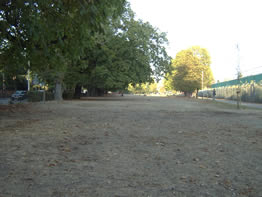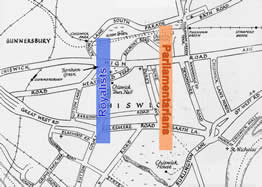Battle of Turnham Green

The modern day Acton Common looking toward the position of the parliamentarian army
The raising of the Royal Standard on 22 August 1642 signalled the formal beginning of the Civil War. On 12 October the king’s army left Shrewsbury to try to get ahead of the parliamentarian army under the Earl of Essex, but was forced to offer battle at Edgehill in Warwickshire on 23 October. Although the outcome was inconclusive, the royalists were able to continue their march on London and on 12 November they surprised and defeated two of Essex’s regiments at Brentford.
The parliamentarians' response was to concentrate all of their available forces at Turnham Green, to block any further advance. Essex’s army was reinforced by regiments of the London militia, a new army under the Earl of Warwick and many volunteers. He had perhaps 24,000 men, facing a royalist army of roughly 13,000. Only at Marston Moor in 1644 and Worcester in 1651 were more men deployed on a Civil War battlefield, and these were the largest engagements in British history.
The battlefield was the open space formed by Turnham Green, Acton Green and Chiswick common field. The parliamentarians’ front ran from the modern South Parade to the garden walls of Chiswick House. The royalist army extended from Acton Green across Turnham Green and close to the line of the modern Sutton Court Road, as far south as the modern Elmwood Road.
Essex at first sent an outflanking force of six regiments, probably under John Hampden, on to the high ground north of the royalist army, but then withdrew it. He was content to block the royalists’ further progress towards London and they were too weak to risk a frontal assault on the parliamentarian positions, or to outflank them, especially as the confined battlefield gave little scope for the effective use of their cavalry. After the withdrawal of Hampden’s force the fighting was limited to some skirmishing and an exchange of artillery fire. One account describes troops of royalist horse riding towards the parliamentarian foot, probably as feints, to test their resolution; trying to draw-out the inexperienced soldiers and break their ranks sufficiently for the horse to burst in.
Essex's objective of blocking the royalist advance was made easier because he was operating so close to his base. Londoners willingly sent a hundred cart-loads of food and drink to the army. In contrast, the royalists were in a largely hostile area and were short of ammunition and supplies. Some of the senior figures with Essex hoped that the king’s entourage would be prepared to negotiate his return to Whitehall, followed by meaningful talks. This did not happen, nor did the parliamentarian commanders offer to parley.

The approximate alignment of the royalist and parliamentarian armies at Turnham Green on the modern street map.
The battle of Turnham Green became a stalemate, with the armies facing each other for ‘many hours’ until the royalists drew off during the afternoon, retreating through Brentford to Hounslow Heath. Essex had achieved his objective and did not need to risk his troops by pursuing them. The parliamentarians had fewer than twenty men killed, and royalist losses are unlikely to have been higher.
Although the first Civil War continued until 1646, the royalists never again approached London, which had firmly displayed its loyalty to the parliamentarian cause. The battle of Turnham Green proved to have been decisive in ending the royalists’ hope of capturing London.

